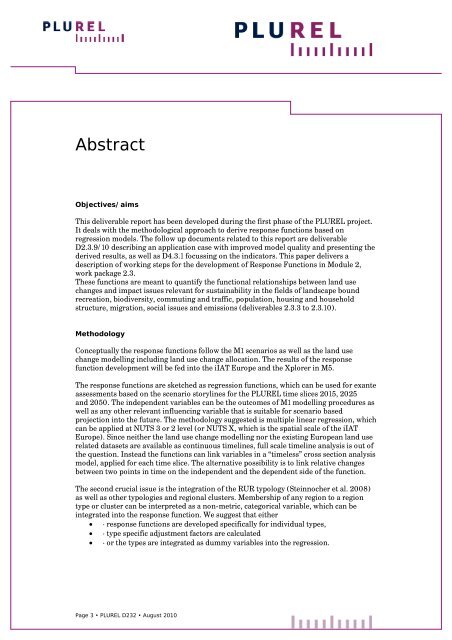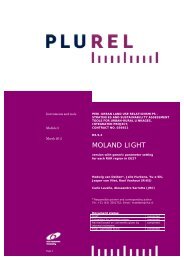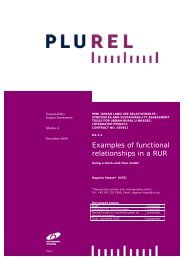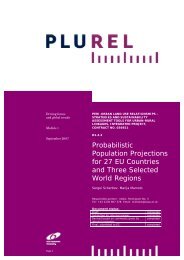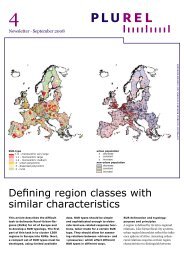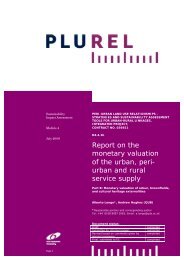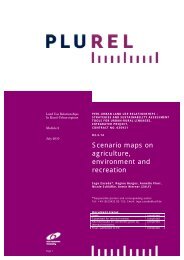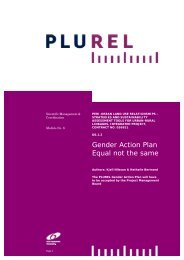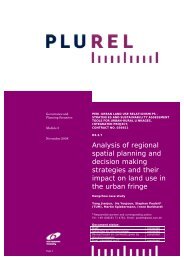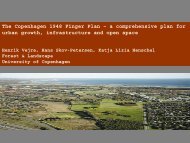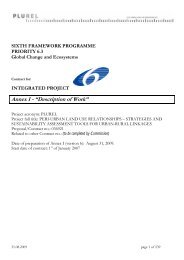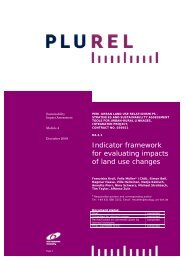Delination of response Functions - Plurel
Delination of response Functions - Plurel
Delination of response Functions - Plurel
- No tags were found...
Create successful ePaper yourself
Turn your PDF publications into a flip-book with our unique Google optimized e-Paper software.
Abstract<br />
Objectives/aims<br />
This deliverable report has been developed during the first phase <strong>of</strong> the PLUREL project.<br />
It deals with the methodological approach to derive <strong>response</strong> functions based on<br />
regression models. The follow up documents related to this report are deliverable<br />
D2.3.9/10 describing an application case with improved model quality and presenting the<br />
derived results, as well as D4.3.1 focussing on the indicators. This paper delivers a<br />
description <strong>of</strong> working steps for the development <strong>of</strong> Response <strong>Functions</strong> in Module 2,<br />
work package 2.3.<br />
These functions are meant to quantify the functional relationships between land use<br />
changes and impact issues relevant for sustainability in the fields <strong>of</strong> landscape bound<br />
recreation, biodiversity, commuting and traffic, population, housing and household<br />
structure, migration, social issues and emissions (deliverables 2.3.3 to 2.3.10).<br />
Methodology<br />
Conceptually the <strong>response</strong> functions follow the M1 scenarios as well as the land use<br />
change modelling including land use change allocation. The results <strong>of</strong> the <strong>response</strong><br />
function development will be fed into the iIAT Europe and the Xplorer in M5.<br />
The <strong>response</strong> functions are sketched as regression functions, which can be used for exante<br />
assessments based on the scenario storylines for the PLUREL time slices 2015, 2025<br />
and 2050. The independent variables can be the outcomes <strong>of</strong> M1 modelling procedures as<br />
well as any other relevant influencing variable that is suitable for scenario based<br />
projection into the future. The methodology suggested is multiple linear regression, which<br />
can be applied at NUTS 3 or 2 level (or NUTS X, which is the spatial scale <strong>of</strong> the iIAT<br />
Europe). Since neither the land use change modelling nor the existing European land use<br />
related datasets are available as continuous timelines, full scale timeline analysis is out <strong>of</strong><br />
the question. Instead the functions can link variables in a “timeless” cross section analysis<br />
model, applied for each time slice. The alternative possibility is to link relative changes<br />
between two points in time on the independent and the dependent side <strong>of</strong> the function.<br />
The second crucial issue is the integration <strong>of</strong> the RUR typology (Steinnocher et al. 2008)<br />
as well as other typologies and regional clusters. Membership <strong>of</strong> any region to a region<br />
type or cluster can be interpreted as a non-metric, categorical variable, which can be<br />
integrated into the <strong>response</strong> function. We suggest that either<br />
• · <strong>response</strong> functions are developed specifically for individual types,<br />
• · type specific adjustment factors are calculated<br />
• · or the types are integrated as dummy variables into the regression.<br />
Page 3 • PLUREL D232 • August 2010


